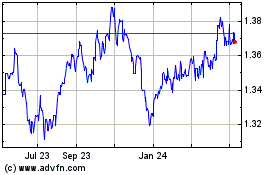Commodity Currencies Slide
October 02 2023 - 11:33PM
RTTF2
Commodity currencies such as the Australia, the New Zealand and
the Canadian dollars weakened against their major currencies in the
Asian session on Tuesday, as the strength of the U.S. dollar
against major currencies in the region and a surge in treasury
yields to its highest level in almost sixteen years has caused
Asian stock markets to trade sharply lower.
Traders also await key monthly U.S. employment data later in the
week for cues on the outlook for interest rates. Asian markets
closed mostly lower on Monday.
Crude oil prices also fell sharply, hurt by a stronger dollar
and concerns about prospects of rising supplies in the market. West
Texas Intermediate Crude oil futures for November sank $1.97 or 2.2
percent at $88.82 a barrel.
The Australian dollar fell further after the Reserve Bank of
Australia held interest rates steady at its first board meeting
under new Governor Michele Bullock.
"The higher interest rates are working to establish a more
sustainable balance between supply and demand in the economy and
will continue to do so," Governor Michele Bullock said.
In the Asian trading today, the Australian dollar fell to nearly
a 1-year low of 0.6311 against the U.S. dollar and nearly a 2-week
low of 94.59 against the yen, from yesterday's closing quotes of
0.6362 and 95.33, respectively. If the aussie extends its
downtrend, it is likely to find support around 0.60 against the
greenback and 93.00 against the yen.
Against the euro and the Canadian dollar, the aussie slipped to
a 6-day low of 1.6578 and a 5-day low of 0.8652 from yesterday's
closing quotes of 1.6461 and 0.8701, respectively. The aussie may
test support near 1.69 against the euro and 0.84 against the
loonie.
The aussie edged down to 1.0682 against the NZ dollar, from
yesterday's closing value of 1.0694. On the downside, 1.05 is seen
as the next support level for the aussie.
The NZ dollar fell to a 6-day low of 0.5904 against the U.S.
dollar and a 5-day low of 88.50 against the yen, from yesterday's
closing quotes of 0.5945 and 89.08, respectively. If the kiwi
extends its downtrend, it is likely to find support around 0.57
against the greenback and 87.00 against the yen.
Against the euro, the kiwi dropped to a 4-day low of 1.7726 from
Monday's closing value of 1.7610. On the downside, 1.81 is seen as
the next support level for the kiwi.
The Canadian dollar fell to more than a 6-month low of 1.3716
against the U.S. dollar and nearly a 2-week low of 109.27 against
the yen, from yesterday's closing quotes of 1.3676 and 109.56,
respectively. If the loonie extends its downtrend, it is likely to
find support around 1.38 against the greenback and 107.00 against
the yen.
Against the euro, the loonie edged down to 1.4353 from an early
4-day high of 1.4322. The loonie may test support around the 1.45
region.
The safe-haven currencies such as the U.S. dollar and the yen
rose against their major currencies as Asian stock markets traded
higher.
The U.S. dollar rose to a 10-month high of 1.0460 against the
euro and nearly a 7-month high of 1.2061 against the pound, from
yesterday's closing quotes of 1.0476 and 1.2086, respectively. If
the greenback extends its uptrend, it is likely to find resistance
around 1.03 against the euro and 1.19 against the pound.
Against the yen and the Swiss franc, the U.S. dollar climbed to
an 1-year high of 149.96 and a 5-day high of 0.9199 from Monday's
closing quotes of 149.85 and 0.9181, respectively. The greenback
may test resistance around 151.00 against the yen and 0.94 against
the franc.
In economic news, the monetary base in Japan jumped 5.6 percent
on year in September, the Bank of Japan said on Tuesday - coming in
at 669.860 trillion yen. That shattered expectations for an
increase of 1.6 percent following the upwardly revised 1.2 percent
increase in August. The adjusted monetary base surged 31.5 percent
to 676.105 trillion yen. For the third quarter of 2023, the
monetary base climbed 1.8 percent on year.
The yen rose to a 5-day high of 156.75 against the euro and
nearly a 2-month high of 180.78 against the pound, from yesterday's
closing quotes of 156.97 and 181.10, respectively. If the yen
extends its uptrend, it is likely to find resistance around 152.00
against the euro and 174.00 against the pound.
Against the Swiss franc, the yen edged down to 162.98 from
Monday's closing value of 163.14. The yen may test resistance near
the 156.00 region.
Looking ahead, U.S. Redbook report for September is due to be
released in the New York session.
At 8:00 am ET, Federal Reserve Bank of Atlanta President Raphael
Bostic will participate in moderated conversation, "Economic
Outlook for 2024: Inflation, Rising Interest Rates, Labor Market,
and Uncertainties" before the Leadership Atlanta alumni roundtable,
"Where Are We Going? Riding the Financial Rollercoaster: A Forward
Look Beyond 2024", in Atlanta, U.S.
US Dollar vs CAD (FX:USDCAD)
Forex Chart
From May 2024 to Jun 2024

US Dollar vs CAD (FX:USDCAD)
Forex Chart
From Jun 2023 to Jun 2024
